Odds & Ends: Core Set 2021
It's time for my Core Set 2021 mailbag column. As with each set, I reached out on Twitter to answer as many questions as I could.
Here's the tweet I posted:
It's time for me to write a mailbag column about #mtgm21. Please keep your questions about Core Set 2021 to a single tweet, one question per tweet. Thanks. #WotCStaff
— Mark Rosewater (@maro254) June 12, 2020
As always, I'll try to answer as many questions as I can, but here's why I might not answer your question:
- I have an allotted word count, which means that there are only so many questions I can get to.
- Someone else might have asked the same question. I will usually answer the first person who asks.
- Some questions I either don't know the answer to or don't feel qualified enough in the area to answer properly.
Some topics I'm not allowed to answer for all sorts of reasons, including previews for future sets.
Now that I've said that, on with the questions:
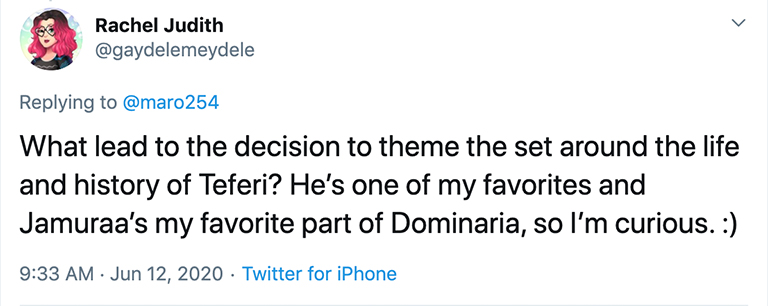
Here's the criteria for a Planeswalker to be the face of a core set:
They have to be a character we feel is a good entry into the game – The core set is the set where we focus a lot on new players and acquisition. That means we want to put our best foot forward, so we try to make sure the face of the set is a Planeswalker we want new players to become acquainted with as an introduction to the game.
They have to be a popular character – We also want to encourage the enfranchised players to buy the core set, so it helps having someone we know the players like. (And yes, I do understand that there's some frustration with Teferi because of some of his cards, but in market research, he scores well. Also, we plan this far ahead, so Teferi was chosen before War of the Spark released.)
They have to be a character that can be expressed as a monocolor card – Core sets always have a cycle of monocolor planeswalker cards, as we want to have a nice embodiment of each of the colors. The face of the set is one of that cycle. The trick to whether a Planeswalker can be monocolor is whether their core is one color or two. For example, Teferi's secondary color is white, but he is a base blue character because time magic is core to blue. In contrast, Saheeli is very blue-red. Her identity is tied to the combination of the colors more than to any one color.
Ideally, they are a character that hasn't been the face of a previous core set – We like every core set to have a different feel, and having a Planeswalker that hasn't already been the face of a core set helps. And, yes, Chandra did break that rule. I chalk this up to Chandra being a rulebreaker.
Taking all this into account, we made a short list and, from that, selected Teferi. Because he had a long history, we knew that we would be able to find numerous legendary characters to connect to him. (More on this below.)

One of the issues that comes up a lot in making a trading card game is that you do something once and players assume it's the start of something. The three Chandras in Core Set 2020 were not intended as the beginning of a new approach to core set Planeswalker faces of the set. It was just a cool idea the Core Set 2020 team had for that product. It's the same reason every core set doesn't have a double-faced planeswalker even though Core Set 2019 had a double-faced Bolas. I don't believe there was ever any plan to have three Teferis in Core Set 2021.

I believe it was something Aaron Forsythe built into the set's vision in vision design. Aaron recognized that core sets have the easiest time incorporating reprints as they don't have the issue of the reprints needing to match the world. He also recognized that the last set of the year (from a rotation perspective) could be the most adventurous in power level as its time in Standard is the smallest.
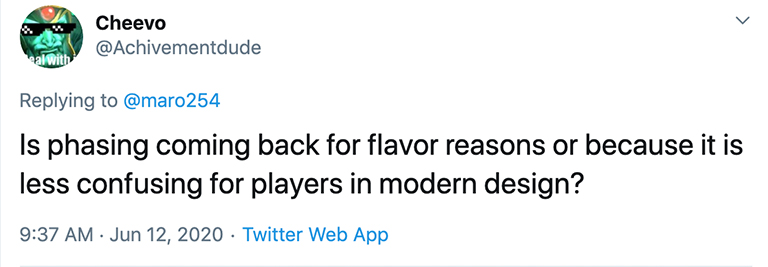
I'm about to utter a sentence I predict few of you will see coming. We're experimenting with making phasing deciduous. What? Let me clarify. We're experimenting with making phasing things out deciduous. Again, what? Let me explain.
Phasing first appeared in Mirage. It was an ability that went on permanents and basically made them disappear every other turn. A creature with phasing would phase in or out, accordingly, at the beginning of your turn. Phasing is different from flickering (exile and returning a creature) as all counters and auras (equipment weren't a thing yet) stay on the creature while it's phased out. Phasing also stopped "enters the battlefield" and "leaves the battlefield" effects. It was essentially a downside mechanic which allowed us to make cards cheaper. But something interesting happened as we started playing around with the mechanic. We realized that it could have a completely other function.
Phasing could also function as a keyword action. You could phase things, meaning they got phased until the start of their owner's next turn. This could be used offensively to remove creatures temporarily or could be used defensively as a way to save your own creatures. Phasing things out would prove long term to be the more interesting use of phasing.
Mirage came and went, and R&D didn't give much thought to phasing (well, other than it inspired me to design flickering), but years later, Mark Gottlieb, who was the Rules Manager at the time, was trying to figure how to make the card Oubliette work in the rules.
Oubliette exiled creatures yet let them keep their stuff (aka counters and auras), but that wasn't how the rules of exiling worked. When a card gets exiled, it loses all the counters and auras. After much problem solving, Gottlieb found the solution to the problem. Have Oubliette phase out the creature. The phasing rules did exactly what the card needed, and phasing was already part of the rules. Problem solved.
Although it solved the problem at hand, something didn't sit right with Gottlieb. He realized that the rules in place for phasing were not the most intuitive. Pseudo-exiling that didn't work like exiling was kind of wonky. What if the phased-out creature didn't actually leave play? What if it was just treated like it was gone without it actually having to leave play? This would explain why things don't fall off of it and why "enters the battlefield" and "leaves the battlefield" effects don't work. The wording was pretty clean, and the ability became a lot more intuitive. Gottlieb worked to change how exactly phasing worked to make it more intuitive.
Years later, the card Teferi's Protection was made in Commander (2017 Edition). This would be the first time the new version of phasing would appear printed on a card.

A few more years later, we're making Core Set 2021. Teferi is the face of the set, so we want to make a cool card for him. One of the abilities exiled the opponent's creature until the end of the turn. Teferi's magic is time-based, so this represented him time-shifting a creature. It mostly worked, but it triggered leaves-the-battlefield and enters-the-battlefield effects, which weakened the ability as it made it unusable on a certain swath of creatures. It also essentially destroyed auras and knocked off equipment which really wasn't the point of the card. The team thought about phasing as it was such a flavor win for the character. It answered both of the problems.
At first, they thought they couldn't bring it back, as it wasn't an evergreen or deciduous keyword and we don't bring back old mechanics in core sets. An argument was raised, though, that the new functionality of phasing might be useful in modern design. It did something that we couldn't quite do with flickering. Maybe it could become a deciduous effect. How would such a decision be reached? Well, we could experiment with it in Core Set 2021 and see the player reaction.
So that, in so many words, is why phasing (or, more accurately, phasing out) is back.

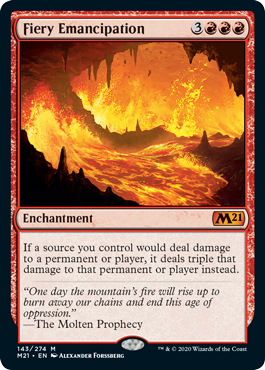
Many years ago, I made the card Furnace of Rath (back in Tempest, the first set I led the design for). I was so excited when I designed it because I thought the idea of doubling all your damage was as over the top as a Magic card could be. I now realize that I wasn't thinking big enough. Hmm, tripling?
Q: What event made dogs and cats settle their differences in order to team up? (@thebombisme1234)
I heard they were raining together, and the topic just came up.
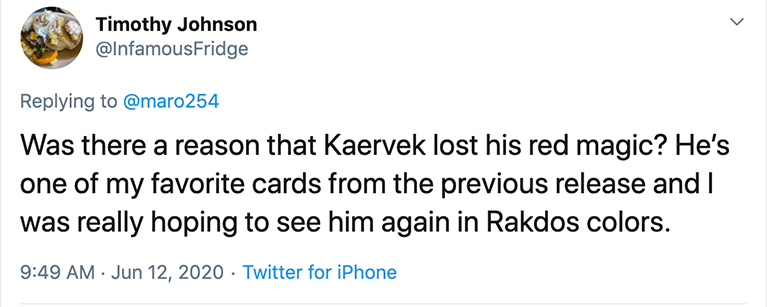
He was part of a cycle of monocolor legendary creatures tied thematically to Teferi. (That cycle is Mangara, Barrin, Kaervek, Subira, and Jolrael.) He's base black, so we felt okay printing him as a mono-black card. Note that this version doesn't mean the character isn't still black-red.

Let's take a look at past core sets and see how many legendary creatures they had.
- Alpha through Magic 2014 – 0
- Magic 2015 – 6
- Magic Origins – 10 (five of which are the cards that turn into planeswalkers)
- Core Set 2019 – 10
- Core Set 2020 – 12
- Core Set 2021 – 10
Okay, it's got two less than last year, but it's in a three-way tie for second for the most ever in a core set, so I don't think I'd say "so little." It also does have a rare cycle of legendary enchantments, although obviously those can't be commanders.
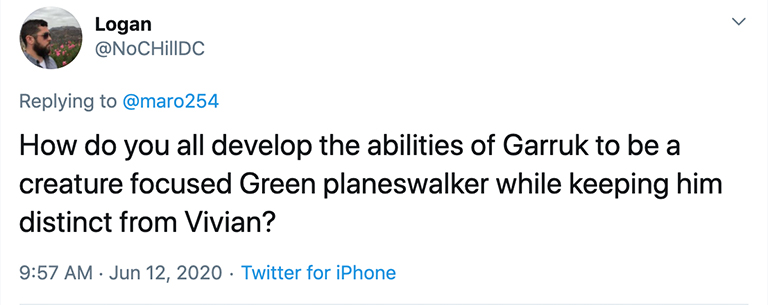
One of the challenges of continually making new Planeswalkers is making sure that we're not cutting too badly into the mechanical design space of an existing planeswalker card. Vivien and Garruk are a great example of this problem. How do we handle it? First off, caring about creatures is a pretty big area, especially in green, so the space to play in is larger than almost any other mechanical space. In other words, green can easily handle two green planeswalkers focused on creatures. Vivien, with her animal bow, is most often trying to find the exact right animal for the job. That's why she often impulses (looks at some number of cards off the top of the library) for creatures. It's also why, for example, her Ikoria planeswalker card lets you customize your token by choosing one of three keyword counters. Garruk, in contrast, makes big, dumb beasts that smash everything in their path. In other words, Vivien uses some subtlety while Garruk doesn't know what that word means. It's not a lot but allows each Planeswalker to have a slightly different feel.
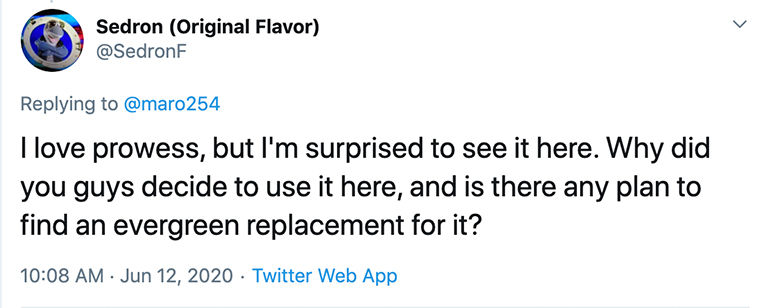
When prowess got demoted from evergreen status, we didn't just kick it out completely, we made it deciduous, meaning it's available to sets that need it, which includes core sets.

We considered all of them, but we had a new Planeswalker we'd designed, and this felt like the right place to debut him. It's often hard fitting new Planeswalkers that aren't part of the story into non-core premier sets. We do enjoy Elspeth, Teyo, and the Wanderer and will find other opportunities for them.
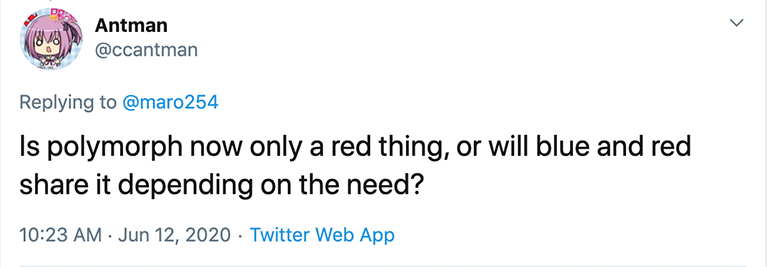
Here's the division. If you're turning a creature into another creature and you don't know what you're going to get, that's now red. If you know what you're turning the creature into, that's blue. The Polymorph ability (named after the card Polymorph from Mirage) is mostly the former, so that's now a red ability.

Here's my best guess at what happened. Green rare and mythic rare were probably pretty tight (R&D slang for "there are more cards than we can fit in the available slots"), so they moved the Hydra down to uncommon.
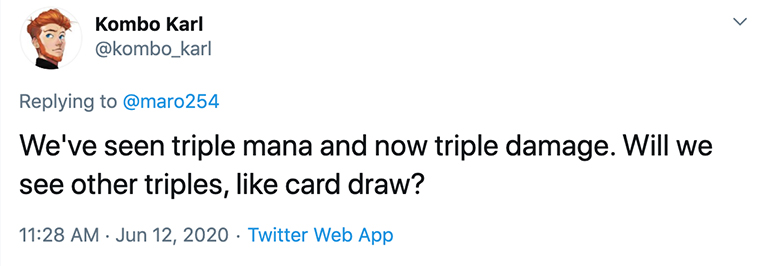
We will if I have anything to do with it.

Milling was already essentially evergreen in that we do it in almost every set. All we did with the ability was give it a keyword action (aka name it). If history has anything to do with it, though, having a keyword tends to increase how much we use something.
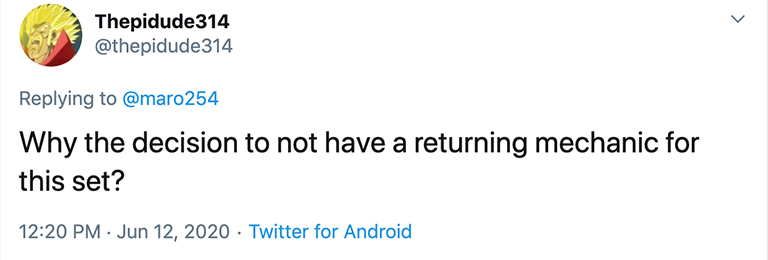
Ever since core sets returned with Core Set 2019, we ended the practice of bringing back a keyword. Both phasing and prowess did make the set, though.
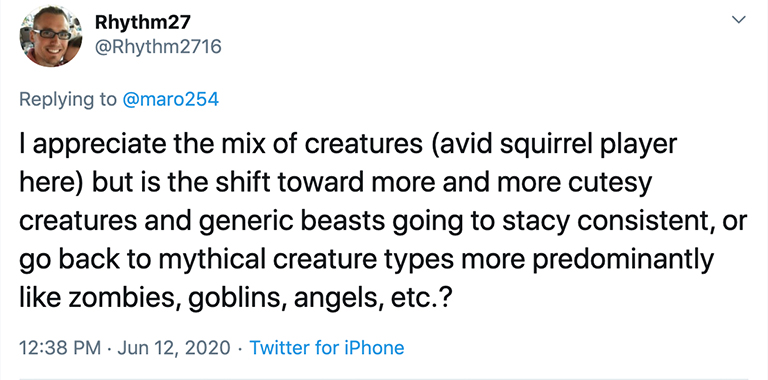
The pendulum swings, but the center of the pendulum is meat and potatoes fantasy creatures. The fanciful Cats and Dogs of Core Set 2021 is not a sign that you won't be seeing plenty of Goblins and Zombies in the future.
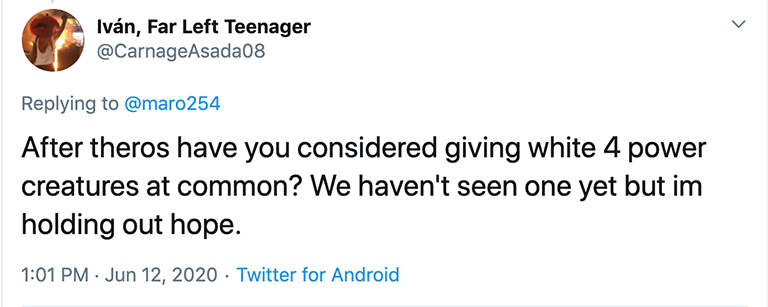
We've removed the restriction that white can't have 4-power creatures at common. This doesn't mean every set will have them, just that it's no longer off-limits. (For those not in the know, until very recently, R&D had an internal rule that said white couldn't have a 4-power creature at common.)
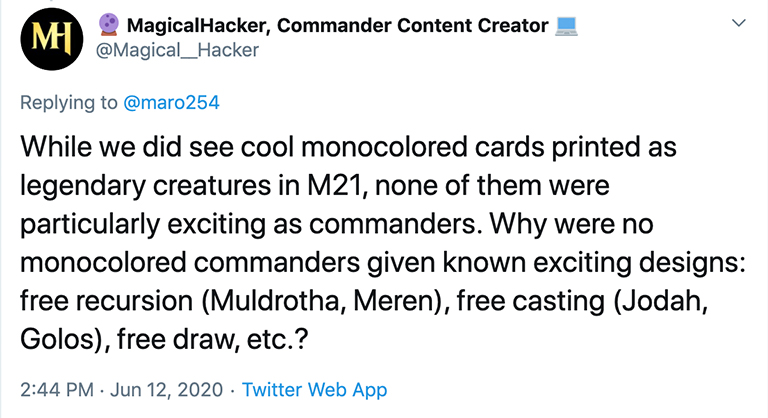
Because legendary creatures play such a central role in the Commander format, I think there's this misconception that all legendary creatures are designed specifically for Commander. There are many players who don't play Commander that also enjoy legendary creatures, and we have to design for them as well.
The Curtain Closes
That's all the time I have for today. I hope you all enjoyed the questions and answers. Thanks to everyone who sent a question in, and I'm sorry if I wasn't able to get to yours. As always, I would appreciate any feedback on my column or Core Set 2021. You can reply to me via email or contact me through any of my social media accounts (Twitter, Tumblr, Instagram, and TikTok).
Join me next week when I talk about the future of Magic.
Until then, may you play some Core Set 2021 and come up with some new questions.
#751: Christine Sprankle
#751: Christine Sprankle
32:12
In this podcast, I talk with Christine Sprankle, one of the best-known Magic cosplayers.
#752: April King
#752: April King
33:17
In this podcast, I talk with April King about the challenges of keeping a Magic database and about the community of Magic Twitter.
- Episode 750 Skaff Elias
- Episode 749 Jimmy Wong & Josh Lee Kwai
- Episode 748 Blake Rasmussen

